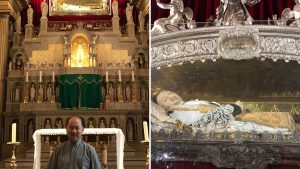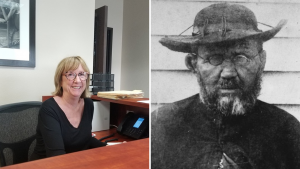The Saints can encourage and inspire us! Having celebrated All Saints Day on November 1st, we asked each staff member at Holy Trinity to share their favorite Saint with us. We hope you enjoy the following reflections…
ANDREW WATSON
Youth Minister / Confirmation Coordinator
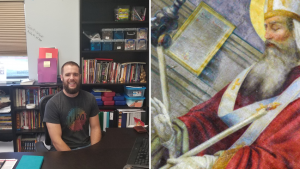
As far back as I can remember, whenever anyone has asked who my favourite Saint was, my answer was always “St. Blaise”. However, if you had asked me who he was and what he did I couldn’t have told you. It turns out I wasn’t the only one. Not a lot is known about St. Blaise. Most of what we do know about St. Blaise comes from writings 400 years after his death and from traditions that have been passed down over generations. Many people know about devotions to St. Blaise but don’t actually know much about the man himself. For the longest time I didn’t either. I just looked forward to his feast day every year. It is perhaps one of my earliest memories of going to church as a child. But first, here is what we do know about Blaise…
Saint Blaise was the bishop of Sebastea and a doctor. The first known record of the saint’s life comes from the medical writings of Aëtius Amidenus, where he is recorded as helping with patients suffering from objects stuck in their throat. Saint Blaise is believed to begin as a healer then, eventually, became a “physician of souls.” He then retired to a cave, where he remained in prayer. People often turned to Saint Blaise for healing miracles. In 316, the governor of Cappadocia and of Lesser Armenia, Agricola, arrested then-bishop Blaise for being a Christian. On their way to the jail, a woman set her only son, who was choking to death on a fish bone, at his feet. Blaise cured the child, and though Agricola was amazed, he could not get Blaise to renounce his faith. Therefore, Agricola beat Blaise with a stick and tore at his flesh with iron combs before beheading him. In another tale, Blaise was being led to the prison in Sebastea, and on the way came across a poor old woman whose pig had been stolen by a wolf. Blaise commanded the wolf return the pig, which it did -alive and uninjured – to the amazement of all. When he reached Sebastea, the woman came to him and brought two fine wax candles in an attempt to dispel the gloom of his darkened cell. In the Middle Ages, Blaise became quite popular and his legend as a beast tamer spread. He was then referred to as the “saint of the wild beast.” Saint Blaise is often depicted holding two crossed candles in his hand, or in a cave with wild animals. (catholicsaints.org)
St. Blaise’s popularity arose from the fact he had performed miraculous cures. That led those who were sick, especially with throat ailments, to seek his intercession. Eventually the custom of the blessing of throats arose, whereby the priest held two crossed candles over the heads of the faithful or touched their throats with them while he invoked the prayer of the saint and imparted God’s blessing (catholiceducation.org)
One of my earliest memories of going to Mass at St Bernadette’s back home in Tullibody, Scotland was the Feast of St Blaise. Our parish priest Fr. Wallace had a devotion to St Blaise and every year on February 3rd the whole congregation would go up to the Altar to have their throats blessed. I always remember Fr Wallace would place two candles across my throat and say the following prayer…
“Through the intercession of St. Blaise, bishop and martyr, may God deliver you from every disease of the throat and from every other illness, in the name of the Father, and of the Son, and of the Holy Spirit.”
For some reason that devotion and practice always stood out to me. It was a quirky part of our Catholic faith that made me aware of the richness of our traditions and the fact there was some pretty weird and wonderful Saints out there. While I went the longest time not actually knowing anything about St Blaise, he was actually interceding in my life from a very young age. He sparked my interest, through Fr Wallace’s devotion, in being Catholic and made me look forward to going to Mass to learn new things. His patronage of throat ailments encouraged me to explore who other Patron Saints were and what devotions people had to them. His sainthood led me to a greater understanding that there is a Communion of Saints, holy people who have gone before but still watching over us, praying for us, and interceding on our behalf. He led me closer to God.
He is my favourite saint and I don’t really know that much about him…nobody does. In the end though it isn’t really about knowing St Blaise, but about knowing who God is. St Blaise did his job as a Saint and paved the way for me to know God.
ANGELA JOHNSON
Business Manager
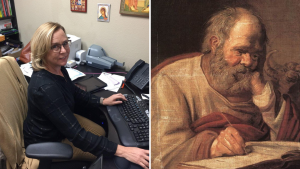
Luke wrote one of the major portions of the New Testament, a two-volume work comprising the third Gospel and Acts of the Apostles. In the two books he shows the parallel between the life of Christ and that of the Church. He is the only Gentile Christian among the gospel writers. Tradition holds him to be a native of Antioch, and Paul calls him “our beloved physician.” His Gospel was probably written between 70 and 85 A.D. Luke appears in Acts during Paul’s second journey, remains at Philippi for several years until Paul returns from his third journey, accompanies Paul to Jerusalem, and remains near him when he is imprisoned in Caesarea. During these two years, Luke had time to seek information and interview persons who had known Jesus. He accompanied Paul on the dangerous journey to Rome where he was a faithful companion. Luke’s unique character may best be seen by the emphases of his Gospel, which has been given a number of subtitles:
1) The Gospel of Mercy
2) The Gospel of Universal Salvation
3) The Gospel of the Poor
4) The Gospel of Absolute Renunciation
5) The Gospel of Prayer and the Holy Spirit
6) The Gospel of Joy
(Franciscanmedia.org/saint-luke/)
Why I Admire Saint Luke: Luke was an evangelist. There is a warmth to Luke’s writing that sets it apart from that of the other synoptic Gospels. Christs’ humanity in Luke’s gospel is most relatable for me. I also like that this Gospel provides details concerning the births of John the Baptist and Jesus. Luke tells us of the Annunciation, the circumstances surrounding Christ’s birth in Bethlehem and the announcement of His birth to the shepherds. Finally, the parables of the prodigal son and of the rich man and Lazarus (two of my favorites) are only found in Luke.
PAULA BAYTIEH
Sacramental Preparation
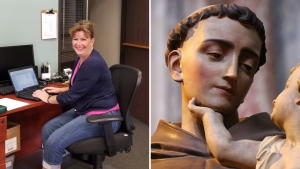
“St. Anthony your help abounds…something is lost that must be found”
St. Anthony of Padua 1195-1231
My favorite Saint is St. Anthony of Padua who is also known as the patron saint of “lost things” there have been more times than I can count when I can’t seem to find something I need or misplaced & will say this quick prayer asking for help, and every time that “something” has turned up…not always immediately mind you but it has been found sometimes weeks later. When we talk about the saints in Faith Formation classes, St. Anthony is the one I often share with the students.
Saint Anthony was born Fernando Martins in Lisbon, Portugal. He was born into a wealthy family and by the age of fifteen asked to be sent to the Abbey of Santa Cruz in Coimbra, the then capital of Portugal. During his time in the Abbey, he learned theology and Latin. Following his ordination to the priesthood, he was named guest master and was responsible for the abbey’s hospitality. Fernando eventually received permission to leave the Abbey so he could join the new Franciscan Order. When he was admitted, he changed his name to Anthony.
Anthony then traveled to Morocco to spread God’s truth, but became extremely sick and was returned to Portugal to recover. The return voyage was blown off-course and the party arrived in Sicily, from which they traveled to Tuscany. Anthony was assigned to the hermitage of San Paolo after local friars considered his health.
As he recovered, Anthony spent his time praying and studying.
Anthony had a book of psalms that contained notes and comments to help when teaching students and, in a time when a printing press was not yet invented, he greatly valued it. When a novice decided to leave the hermitage, he stole Anthony’s valuable book. When Anthony discovered it was missing, he prayed it would be found or returned to him. The thief did return the book and in an extra step returned to the Order as well. The book is said to be preserved in the Franciscan friary in Bologna today.
ANGELINE TRUDELL
Lead Principal – St Junipero Serra Catholic School

Today, on the Feast Day of St. Pope John Paul II, our Saint of the Staff comes from Mrs. Angeline Trudell, Lead Principal of our Parish School – St. Junipero Serra Catholic School. Mrs. Trudell shares with us why our former Pope is now one of her favorite Saints…
“Do not be afraid! Open wide the doors for Christ….”
St. Pope John Paul II, 1978
Born May 18, 1920
Home to God April 2, 2005
Canonized by Pope Francis April 27, 2016
The papacy of St. Pope John Paul II focused on love for Christ, prayer to bring us closer to Christ, and peace found in the heart of Christ. He dedicated his life to the Missionary work and was not afraid to search for peace, even through violence. St. Pope John Paul II was an avid writer with many of his writings guiding the lives of all Christians throughout the world. St. John Paul II legacy was one the is reflected in one of his final writings and this quote…
“The whole of the Christian life is like a great pilgrimage to the house of the Father, whose unconditional love for every human creature… we discover anew each day”.
St. Pope John Paul II ‘s love for Christ and teaching us how to follow Christ through both the gifts of life and the challenges of life are why he remains so special to me in my heart. My mom and dad both faced many adversities in their lives as immigrants, mostly illness. My mom taught me to never be afraid and would often read to me from the writings of St. Pope John Paul II. His role model of love of Christ focuses me daily in my ministry here at St. Junipero Serra Catholic School, as a mom, grandmother and wife.
LYSSA ROLLOLAZO
Fundraising & Events

I’ve been a Christian my whole life. However, I am only 10 years into being a Catholic. So, I am still in wonder and awe over The Holy Communion of Saints. Knowing there are hundreds of angels and saints watching over me and praying on my behalf, gives me a sense of peace, protection, acceptance and belonging I have never known before.
One of my favorite saints is St. Monica of Hippo. St. Monica was one of the earliest Christian Saints. She was relentless in prayer; asking Lord Jesus for the salvation of her pagan husband and son. Her husband was violent and unfaithful. Her son was arrogant and wayward. Yet, for seventeen years, St. Monica prayed, begging for her family to turn to Christ. She was bold in those times with her requests. Christianity was far from popular and women were not seen as influential in society. Still, St. Monica persisted for seventeen years! Once, St. Monica asked a bishop to meet with her son and the bishop refused because he knew her son’s mind and heart were closed to the word of God. St. Monica begged the bishop to change his mind. He still refused, but offered some words of hope when he said “Surely the son of so many tears will not perish.” Imagine, praying for seventeen years and only receiving this glimmer of hope. Yet, St. Monica persisted in prayer.
Praise be to God, St. Monica’s husband accepted Jesus into his heart on his deathbed! It’s safe to say her son became a sound Christian too, as he is none other than St. Augustine of Hippo, Doctor of the Church, and highly revered saint, philosopher and theologian! I truly admire St. Augustine as well because his journey to faith was not like mine. I don’t ever remember living a day of my life without Jesus; but, it wasn’t so easy for St. Augustine. He doubted, denied, and sought many other religions before truly living out his destiny as a beloved son of God.
As Father Reynold pointed out, this Sunday’s scripture was all about perseverance and prayer. St. Monica is the perfect saintly example of prayerful perseverance. Could God have granted her heart’s desire sooner than the seventeen years St. Monica spent in torment over her son’s fate? Of course! But, God’s timing is always perfect. Perhaps, the work that God was doing in St. Augustine’s heart needed time to emerge with power. Perhaps, God was waiting for St. Augustine’s message to be revealed to the people who needed it most. Only God knows why St. Monica needed to wait seventeen years for her prayers to be answered. St. Monica obviously trusted her God, our God, to be faithful and answer her prayers in time.
The world we live in is all about instant gratification, would you wait seventeen years for your prayers to be answered without giving up hope? No matter how desperate, repetitive, simple, or extravagant, prayer is our lifeline to God the Father. Romans 12:12 reminds us to be “joyful in hope, patient in affliction, and faithful in prayer.” If you need encouragement in your prayer life, I embolden you to ask for intercession from our St. Monica of Hippo, the patron saint of mothers and wives—admired for her patience, perseverance, prayerful disposition, and deep faith. Her feast day is celebrated on August 27th.
FR JOHN DUY NGUYEN
Parochial Vicar
St. Vincent de Paul was born at Pouy in Gascony in the south of France. He was ordained on September 23, 1660 at the age of nineteen or twenty. Among his chief reasons for becoming a priest was his desire to get an office in the Church from which he could obtain enough money to retire early, return home, and provide for his family.
St. Vincent experienced a twofold conversion. First, he was being converted to the poor, who were becoming the center of his life. Second, he was also being converted to his priesthood, seeing it not as a career, but as a personal relationship with Jesus. However, his conversion does not seem to rest on one dramatic moment, but rather on a gradual opening to the power of God’s grace working in him, and allowing him to see his world more clearly in the light of Christ.
Eventually, he established the Congregation of the Mission – later known as the Vincentians. The purpose of the Congregation of the Mission is to follow Christ evangelizing the poor. Later, with St. Louise de Marillac, he founded the Daughters of Charity to serve the poor and the sick. As a man of deep faith, keen intellect, and enormous creativity, he has become known as the “The Apostle of Charity” and “Father of the Poor.” St. Vincent brought together as many people as he could, rich and poor, humble and powerful, and used every means to inspire in them a sensitivity to the poor, who are the privileged image of Christ. He moved them to help the poor directly and indirectly (Constitutions of the Congregation of the Mission, Introduction, p.19).
His contributions to the training of priests and organizing parish missions and other services for the poor shaped our Church’s role in the modern world. St. Vincent also has a beautiful spirituality of simplicity of live, humility, self-giving & self-denying. His spirituality was based on the encounter with Christ in the needs of one’s neighbor.
As he instructed his priests and sisters, “The poor are your masters and you are their servants.”
St. Vincent died on September 27, 1660, at the age of eighty. He was later named patron of all charitable societies.
CHENTEL TABBADA
Director of Faith Formation
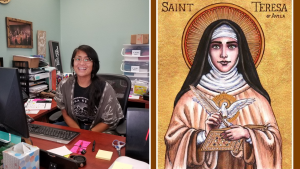
St Teresa of Avila was bold and courageous, indeed one tough cookie. What I admire about her most is that her prayer life reflected deep intimacy with Our Lord. Michelle Benzinger summed her up perfectly,
“The spicy reformer who transformed her order in bare feet.
A sojourner on a spiritual journey, she conversed with her Creator, using humor, wit, and her fierce convictions.
Her “Majesty” taught her the language of castles that brings us all closer together into the throne room.
Making the Kingdom a more illuminated place.”
Listen more here: Abiding Together Podcast S04 E08: Doctors of the Church Part 3: St. Teresa of Avila
Short bio:
March 28, 1515-October 4, 1582. She was sent to the convent at the age of 16 by her father. She reformed the Carmelite order at the age of 43, determined to go back to the basics of a contemplative order: a simple life of poverty devoted to prayer. She is the founder of the Discalced Carmelites. In 1970 she was declared a Doctor of the Church for her writing and teaching on prayer. She is the patron saint of headache sufferers (definitely helpful when I get migraines!) and Spanish Catholic Writers. (Source: catholic.org)
Favorite book: The Interior Castle
Favorite quotes:
After she died, St. Teresa of Avila appeared to one of her nuns and said:
“There should be no difference, as far as purity and love are concerned, between the blessed in Heaven and the faithful on earth, though we are perfectly happy and you are suffering. What the Divine Essence is to us in Heaven, the Blessed Sacrament should be to you on earth.”
“Here, then,” says St. Alphonsus Ligouri, “is our heaven on earth -the Most Blessed Sacrament.” (twofer!)
Fun fact: We share the same birthday, March 28 except her birth year is 1515. 😉 I see her as an older sister that not only keeps me in check, but also prays for me.
FR REYNOLD
Pastor
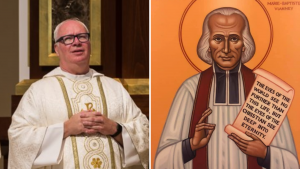
As we approach All Saints Day and our “Get to Know the Saints” event, our next favorite saint of the Holy Trinity Staff comes from Fr Reynold! See below for a reflection from our Pastor on why he loves St. John Vianney.
St. John Vianney: Patron Saint of Parish Priests (So predictable! I know. But also not unpredicatable.)
I was given a book years ago by one of my French Nun friends. It was about St. John Vianney, the Cure d’Ars by Abbe Francois Trochu. It was a rather thick book written in a pious style that was popular in the 1920s and 30s. I was instantly fascinated by this man, this priest Jean-Marie-Baptiste Vianney.
There have been a lot of priests who are recognized as saints. But John Vianney is the patron saint of parish priests like me. John Vianney was born in rural France in May, 1786. This was just before the French Revolution and the social and political upheaval that ensued. The “Reign of Terror” decimated the clergy and destroyed much of the Church in France. It was illegal and dangerous to be a priest, or to be loyal to the Roman Catholic Church. The Vianney family during this period hide faithful priests, attended clandestine Masses, and practiced charity and faith even though to be caught could be a death sentence. John Vianney made his 1st Communion and Confirmation in secret under these political conditions.
In 1802, Napoleon Bonaparte restored the Roman Catholic Church in France. And at age 20 Jean Vianney left the family farm and piously began studies which he hoped would lead him to priesthood. But because of a previous lack of education, and his humble background he was a terrible student. Studies didn’t come easily for him, especially his Latin lessons. Latin was a necessity to be a priest at that time. With a patient priest as his mentor he struggled on.
Seven years later, in 1809, he was drafted into Napoleon’s army. But because of frail health, he missed his troops deployment. When he recovered he was sent to join the army in a neighorboring town, but various circumstances caused him to be AWOL, really a deserter. He again was dangerously avoiding the politics of the day, hiding from authorities in the backwater mountain village of Les Noe in the Auvergne. He was exiled in hiding there for 18 months or so. But during that time he began a school to educate children in the village. But most importantly, he began to teach them about prayer and faith. In effect, he was their CCD catechist.
In 1810 all deserters were granted amnesty, so John Vianney was able to return to his studies. He entered the Seminary, both minor and major, but continued to have academic trouble. He was considered “slow” or incapable of much intellect. He would have been dismissed from the Seminary except that his piety was noted by his priestly mentor, Fr. Belley. As his advocate, Fr. Belley petitioned his Bishop, so that John Vianney was finally ordained a priest in 1815 at the age of 29.
Three years into his priesthood John Vianney was sent to the village of Ars (pop. 230). He was to be the “Cure”, that is the French term for Pastor. From that point on he came to be known as the Cure of Ars. This was the parish he served for the rest of his life. During his time as Pastor there, he realized that the people of the village were not full of faith at all. He began a long work of catechizing them, challenging them, and forgiving them. He was scrupulously pious. He practiced physical mortification, preached against dancing and other frivolous pleasures, and lived quite austerely. He became known as a holy Confessor who could read souls and could bring about healing grace by his absolution. And while he demonstrated God’s love and mercy, he was also reknown as someone who constantly fought manifestations of the devil. He knew spiritual warfare. But he also realized that if he was tormented greatly, that a “big sinner” would soon be coming to Confession.
John Vianney also felt great responsibility for the souls that were entrusted to his care. As renown of his spiritual gifts and personal holiness spread, great crowds would come to him. He would spend 16 to 18 hours a day in the confessional. By 1855, an estimated 20,000 pilgrims come to him for Confession. As his fame grew, he yearned for a quiet life of monastic prayer. At least 4 times he literally ran away from Ars, only to be chased down and brought back by his parishioners.
John Vianney died at the age of 73 in 1859. Thousands attended his funeral. And his cause for canonization began almost immediately.
Above, is a brief biography of St. John Vianney. But his biography isn’t why he is special to me. It’s his obvious zeal for his vocation, his tremendous work ethic, his profound wisdom in dealing with people, his delicacy in encouraging grieving, wounded souls and his dedication to Christ and the Church that make him one of my heavenly mentors. I empathize with him. I know that he empathizes with me. Plus I think he’s kind of weird, and human, and a warrior, and humble, and most beautifully, an example of how Jesus transforms us and loves us into everlasting life.
PATTI WIECKERT
Adult Faith Formation/Adult Confirmation/RCIA

“Greater love than this no man hath, that a man lay down his life for his friends.” – John 15:13
That verse certainly comes to mind whenever I think of St. Maximilian Kolbe, whose feast we celebrate on August 14. So it’s not surprising to read that these were the opening words of the papal decree introducing his beatification. St. Maximilian Kolbe was arrested in Poland in February of 1941, and in May sent to the Auschwitz death camp. As prisoner #16670, he eventually laid down his life for another prisoner on August 14, 1941, at the young age of 47. When a prisoner escaped late in July of that year, ten men from his barracks were picked to suffer death by starvation as both punishment and deterrent.
Fr. Maximilian offered to take the place of one of the men;
Franciszek Gajowniczek had let out a cry of pain for his family and this holy priest volunteered to take his place. What followed were weeks of unimaginable horror, as the men suffered the pains of dehydration and starvation. But this holy man not only offered to be one of the suffering, he ministered to them as well. After three weeks there were only four prisoners left alive. In 1941, the day before the Church celebrated the Assumption of St. Maximilian’s beloved Mary, the Immaculata, Fr. Kolbe and three fellow prisoners were killed with injections of carbolic acid. By the late 1940’s the cause for Fr. Kolbe’s beatification had begun. He was beatified by Pope Paul VI in 1971 and canonized by his fellow Pole, Pope John Paul II in 1982.
St Maximilian Kolbe, pray for us!
SUSAN NEWTON
Parish Receptionist
We all aspire to be heroes. But as Christians, our goal is so much more than being a hero in the eyes of the world. We strive to become saints—like Saint Damien de Veuster—who built a culture of life in our society. Saint Damien served the lepers of the Hawaiian Islands for 16 years, giving up his life and his health in order to bring comfort to the most hated and feared people in society.
Saint Damien lived the gospel of life. He saw Jesus in every person he met, even when they were horribly disfigured by Hansen’s disease. When he couldn’t get proper medical supplies for his lepers, he wrote scathing letters to the Board of Health in Honolulu to get them to see the humanity of the lepers. His outspokenness and persistence helped conditions on the island improve.
With his skill as a carpenter, Saint Damien and the inhabitants built suitable homes, a chapel, rectory, school, and hospital. After over a decade of service on Molokai, Saint Damien himself contracted leprosy and died after serving 25 years as a missionary to the Hawaiian Islands. His feast day is May 10. The story of Saint Damien is a great reminder that we should always treat others with respect and dignity—as members of our human family—no matter what their outward appearance, age, or ability.
Saint Damien, pray for us!


